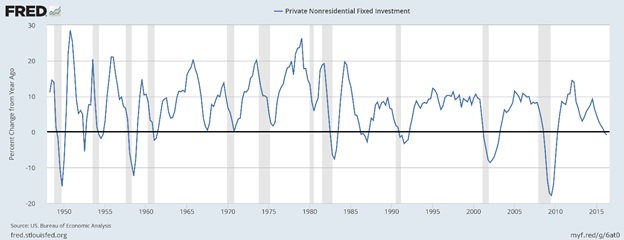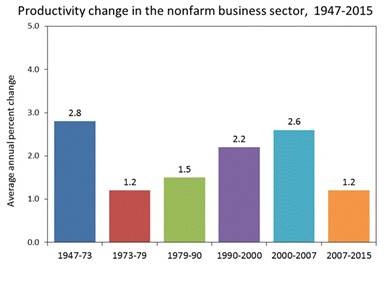Real GDP growth grew just 1.2% in the last quarter. It will likely be revised up, but it’s still a disappointing figure.
Another figure that disappointed was a broad measure of capital spending by U.S. businesses: year-over-year growth in private nonresidential fixed investment, which went negative during the quarter, registering a 0.8% decline over the same period in 2015. On 8 of 11 such occasions over the past 60 years, such a negative turn has occurred during a recession.
Some of the downturn is due to the continuing reduction of capital expenditures in the energy sector, but not all of it. Deutsche Bank noted in a research piece this week:
“The only pocket of strength within the nonresidential fixed investment sector was intellectual property products; this category, which includes software, R&D, and entertainment, literary and artistic originals, advanced a modest 3.5% in the quarter, and at a similar rate over the last year. While some of the weakness in investment spending has been due to the collapse in oil prices, non-energy-related spending has been soft, too... While investment spending may get a slight boost over the next couple of quarters as the energy investment drag abates, we expect corporate outlays to remain stagnant until next year.”
Shaded areas indicate U.S. recessions:
Faltering capital expenditures means that overarchingly, U.S. companies are not reinvesting in their own organic growth. We would expect productivity growth to suffer as a consequence, and indeed, it has.
Nonfarm business sector labor productivity decreased at a 0.6-percent annual rate during the first quarter of 2016. The period from 2007 to 2015 showed a level of productivity growth significantly below the long-term average -- more like that last seen during the stagflation of the early 1970s.
Faltering capital expenditures mean faltering productivity growth… faltering productivity growth means faltering wage growth… faltering wage growth means falling living standards… and thus, if the process continues, the virtuous circle linking consumer demand with business expansion is broken.
Unless businesses raise capital expenditures, it will be difficult to improve the living standard of the disgruntled U.S. workers (who are clearly expressing their displeasure with the status quo during this present election).
Why are so many U.S. businesses taking advantage of abundant easy money to engage in stock buybacks and financial engineering rather than reinvesting in their own organic growth? And why has the shift been particularly noteworthy over the past ten years?
We think for several fundamental reasons:
- Increasing levels of government indebtedness, which has been shown to depress economic growth. Businesses see the writing on the wall: ballooning debt levels imply a future of higher taxes and fiscal constraint.
- Increasing levels of burdensome regulation and the expense this entails for business -- perhaps particularly the Affordable Care Act.
- High headline corporate tax rates for U.S. businesses -- the highest of the advanced economies. Loopholes and creative accounting make those rates lower for some businesses and industries, but also create a more opaque tax regime. In turn, that creates winners and losers based on cleverness in tax avoidance rather than on the real creation of value.
We believe that the key to unlocking businesses’ desire for reinvestment in their own growth is the reduction of these burdens -- debt, regulation, and taxes. That in turn will unlock productivity growth and wage growth, and restart the virtuous cycle of a consumer-driven economy.
Which path the U.S. economy follows will depend on the policies that emerge following the 2016 presidential election. Should the victor continue the policies that brought us here -- excessive spending and debt, increasingly burdensome and ineffective regulation, and an opaque and uncompetitive corporate tax regime, we anticipate that the present environment of sluggish growth and stagnation will continue.
(Note that we are non-partisan -- we can see both positive and negative elements in each major party platform).
Investment implications:
Capital expenditures remain very sluggish, capping a sub-par decade with an outright decline in the first quarter of 2016. With businesses loath to reinvest in their own growth, and instead either hoarding cash or using it to buy back stock or engage in financial engineering, prospects for labor productivity growth and rising living standards are being dimmed.
In a year of insurgent politics, debate will turn to policies that can restart the virtuous cycle of capital expenditure, productivity growth, wage increases, and consumer demand growth. We will carefully watch the policy prescriptions that emerge as the election campaign proceeds.
What we hope to see is policy that will help address the root causes of businesses’ hesitation to expand -- excessive spending and debt, an increasingly burdensome regulatory environment, and an uncompetitive corporate tax regime.


